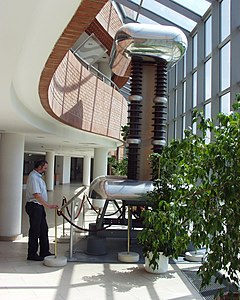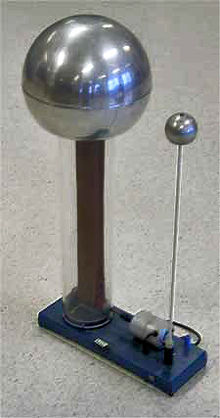The Westinghouse Atom Smasher, an early Van de Graaff accelerator built 1937 at the Westinghouse Research Center in Forest Hills, Pennsylvania. The cutaway shows the fabric belts that carry charge up to the mushroom-shaped high voltage electrode. To improve insulation the machine was enclosed in a 65 ft. pressure vessel which was pressurized to 120 psi during operation. The high pressure air increased the voltage on the machine from 1 MV to 5 MV.
Westinghouse Atom Smasher was a 5 MeV Van de Graaff electrostatic nuclear accelerator
To get an idea on what this actually is we have to study it smaller counterpart.
A Van de Graaff generator is an electrostatic generator which uses a moving belt to accumulate electric charge on a hollow metal globe on the top of an insulated column, creating very high electric potentials. It produces very high voltage direct current (DC) electricity at low current levels. It was invented by American physicist Robert J. Van de Graaff in 1929.[1] The potential difference achieved by modern Van de Graaff generators can be as much as 5 megavolts. A tabletop version can produce on the order of 100,000 volts and can store enough energy to produce a visible spark. Small Van de Graaff machines are produced for entertainment, and for physics education to teach electrostatics; larger ones are displayed in some science museums.
The Van de Graaff generator was developed as a particle accelerator for physics research; its high potential is used to accelerate subatomic particles to great speeds in an evacuated tube. It was the most powerful type of accelerator of the 1930s until the cyclotron was developed. Van de Graaff generators are still used as accelerators to generate energetic particle and X-ray beams for nuclear research and nuclear medicine.
An electrostatic generator, or electrostatic machine, is an electromechanical generator that produces static electricity, or electricity at high voltage and low continuous current. The knowledge of static electricity dates back to the earliest civilizations, but for millennia it remained merely an interesting and mystifying phenomenon, without a theory to explain its behavior and often confused with magnetism. By the end of the 17th century, researchers had developed practical means of generating electricity by friction, but the development of electrostatic machines did not begin in earnest until the 18th century, when they became fundamental instruments in the studies about the new science of electricity. Electrostatic generators operate by using manual (or other) power to transform mechanical work into electric energy. Electrostatic generators develop electrostatic charges of opposite signs rendered to two conductors, using only electric forces, and work by using moving plates, drums, or belts to carry electric charge to a high potential electrode. The charge is generated by one of two methods: either the triboelectric effect (friction) or electrostatic induction.Forest Hills, Pennsylvania. It was instrumental in the development in practical applications of nuclear science for energy production. In particular, it was used in 1940 to discover the photofission of uranium. It was the first industrial Van de Graaff generator in the world,[1] and marked the beginning of nuclear research for civilian applications. Built in 1937, it was a 65 feet (20 m) tall pear-shaped tower.[1][2] It went dormant in 1958. In 1985, it was named an Electrical Engineering Milestone by the Institute of Electrical and Electronics Engineers.
How it worked
In a Van de Graaff generator, invented in 1929 by Robert J. Van de Graaff, an endless fabric belt carries electric charge into a round hollow electrode, developing high voltages. In the Westinghouse machine, two belts traveled up a 47 ft. shaft to a mushroom-shaped electrode inside the dome[9] (see cutaway drawing below). The high voltage was used to accelerate subatomic particles to high speeds as they traveled down an evacuated 47 ft. accelerator tube parallel to the belts into the base of the machine, where they struck a target to create nuclear reactions. The energy of the particles was equal to the voltage on the machine's electrode. The maximum voltage that a Van de Graaff generator could produce was limited by leakage of the charge off the electrode due to corona dischargeand arcing. At atmospheric pressure, a Van de Graaff machine was limited to around 1 megavolt. So the machine was installed inside a pear-shaped 65 ft. tall, 30 ft. diameter air tank which was pressurized during use to 120 pounds per square inch.[9] The high pressure air improved insulation, reducing charge leakage, allowing the machine to achieve a voltage of 5 megavolts, although it was originally hoped to reach 10 megavolts
instead of using this monster of a machine to produce energy for its citizens it turned is Research into products of Defense under the guise of medical treatment, its appearance was Noble in in the eyes of the community well nonetheless was used to further the nuclear weapons Arsenal. And when it was no longer useful in service it was never turned over to the community for clean energy use. Into we media library decided to build a small version non-nuclear of course. to see just how amazing this machine could produce voltage.

This Van de Graaff generator of the first Hungarian linear particle accelerator achieved 700 kV during 1951 and 1000 kV during 1952.
Look at the typical Van de Graff generator with its large Dome at the top of it but this is not necessary, it could be more streamlined like this example;

A Van de Graaff particle accelerator in a pressurized tank at Pierre and Marie Curie University, Paris
By the 1970s, as much as 14 million volts could be achieved at the terminal of a tandem that used a tank of high-pressure sulfur hexafluoride (SF6) gas to prevent sparking by trapping electrons. This allowed the generation of heavy ion beams of several tens of megaelectronvolts, sufficient to study light ion direct nuclear reactions. The greatest potential sustained by a Van de Graaff accelerator is 25.5 MV, achieved by the tandem in the Holifield Radioactive Ion Beam Facility in Oak Ridge National Laboratory.[citation needed]
A further development is the pelletron, where the rubber or fabric belt is replaced by a chain of short conductive rods connected by insulating links, and the air-ionizing electrodes are replaced by a grounded roller and inductive charging electrode. The chain can be operated at much greater velocity than a belt, and both the voltage and currents attainable are much greater than with a conventional Van de Graaff generator.
Let's take two different electrostatic machines and coupled them together, first we would have to know this information first;
THIS SMALL MOTOR PACKS SOME PUNCH AT 100 WATTS AND WEIGHTS ONLY 200 GRAMS GIVING IT A POWER TO WEIGHT RATION OF 500 WATTS TO THE KILOGRAM
I took a liking to this motor on a recent review I was doing on new Electric motor technology. Although 100 watts and 200 grams weight may not sound impressive, it is when you need power for robotics and other specialist uses the power to weight ratio is important. This is also important for electric vehicle applications where weight is critical. Existing small motors are less than 200 watts per kilogram.
According to SHINSEI CORPORATION, The High Power Electrostatic Motor ( ESM65-TR1) was made as an trial production model is very lightweight compared with the electromagnetic motor of the same power. Since there is almost neither a friction part nor an exothermic part, energy efficiency is more than 95%. Moreover, ESM65-TR1 can show high performance in a vacuum environment. Furthermore, ESM65-TR1 can also be used in a nonmagnetic environment.
HOW DOES IT WORK?
With all the motor technologies being developed this one stood out to me on a recent review. The High Power Electrostatic Motor consists of a rotor, a stator and a shaft. Many electrodes are arranged on the rotor and the stator. An electric charge is electrified at this electrode and a shaft rotates by the attraction and repulsion of those electrodes.
It is possible to control operation of a motor by controlling the timing which changes the electric charge impressed to an electrode.This is an image which shows the state of the electric charge of the electrode on a rotor and a stator.
It opposes, when the polarity of the electrode on a rotor and a stator is +, +, -, and -. And pulls against each other when the polarity is opposite. By changing the polarity of the electrode on a rotor with sufficient timing, control of the rotational speed, brake, reversal operation off a motor is possible.
It is possible to control operation of a motor by controlling the timing which changes the electric charge impressed to an electrode.This is an image which shows the state of the electric charge of the electrode on a rotor and a stator.
It opposes, when the polarity of the electrode on a rotor and a stator is +, +, -, and -. And pulls against each other when the polarity is opposite. By changing the polarity of the electrode on a rotor with sufficient timing, control of the rotational speed, brake, reversal operation off a motor is possible.
I am not sure Electrostatic Motor is the right terminology to be using with this technology as most experimenters may have different ideas and conceptions of what an Electrostatic Motor is. However the performance of this little motor is very impressive and opens many doors to developers where lightweight high power is essential.
I would like to see how far they can push this technology and how large a motor could be developed. I am sure a lot of other dynamics come into the picture that I am way under qualified to comment on or even know about.
I highly recommend visiting the site as they have some embedded videos and a lot more information on testing and performance.
Now couple this motor which could also be made out of plastic with a Van de Graaff generator
Yes let's take these two:
And couple them together what would the results be see video results in this experimental project
So one generates electricity for the antenna to pick up in the other creates a motor force on the other so it continues to put out electricity. Once the electricity is in the air other items can now use atmospheric electricity or would we call static electricity. The faster the motor spins the more atmospheric electricity is put out into the air of course if you had more than one of these you start to get larger amounts of electricity remember to go back to your example how batteries generate more amps how to increase voltage you will use this device in the same manner knowing that anytime you have low voltage. You also have voltage which comes down to it that building the voltage up is not a problem if you have some in the first place. Yes I'm driving this point home into you understand that their words of discouragements, is to get you away from right way of thinking. This is why they produced for you and you have to work to buy it. Get off the hamster wheel and become more independent, experiment and build. And you will be successful in building this project easily because it's already been done.
This has been another project by media library for higher understanding of what is possible around you everyday it is up to you to take these projects in to new directions. We do this every day and soon we will be showing you more and more once you understand the basics of where we get our information thank you for reading our works Media Library.











No comments:
Post a Comment